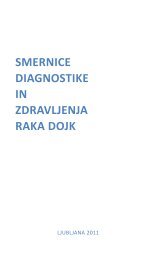You also want an ePaper? Increase the reach of your titles
YUMPU automatically turns print PDFs into web optimized ePapers that Google loves.
Cleavage of uPAR; mechanism and prognostic<br />
significance<br />
Gunilla Høyer-Hansen, Charlotte Almasi, Helle Pappot, Keld Danø<br />
Finsen Laboratory, Strandboulevarden 49, DK-2100 Copenhagen Ø, Denmark<br />
Urokinase (uPA) cleaves its receptor, uPAR, thereby inactivating the binding potential<br />
of this molecule both with regards to uPA and vitronectin. The N-terminal domain<br />
I, uPAR(I) is liberated and the cleaved uPAR(II-III) stays on the cell surface. The<br />
cleavage takes place in the linker region between domains I and II after R 83 and<br />
R 89 . The cleavage is greatly accelerated on the cell surface compared to in solution<br />
and this acceleration is dependent on the uPA-uPAR binding. uPA cleaves glycolipid<br />
anchored uPAR (GPI-uPAR) but not soluble uPAR (suPAR), which lacks the glycolipid<br />
anchor. This is due to a difference in the conformation of the linker region between<br />
domains I and II and not because of a general difference in proteolytic susceptibility,<br />
since GPI-uPAR and suPAR are cleaved with equal efficiency by plasmin. The<br />
collective amounts of all uPAR forms measured by ELISA in tumour lysates or<br />
blood correlates to prognosis in several forms of cancer. However, the amounts of<br />
uPAR(II-III) and uPAR(I) may be directly related to the uPA activity and therefore<br />
be even stronger prognostic markers. Using combinations of monoclonal<br />
antibodies we have designed 3 time-resolved fluoroimmunoassays for the specific<br />
measurements of uPAR(I-III), uPAR(I-III) + uPAR(II-III), and uPAR(I). The amounts of<br />
uPAR(II-III) can be calculated. Applying these assays on tumour extracts from 63<br />
patients diagnosed with squamous cell lung carcinoma revealed a stronger prognostic<br />
impact of uPAR(I) compared to total uPAR as measured by ELISA.<br />
28l14

















